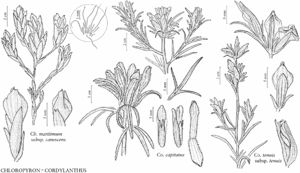familyOrobanchaceae
genusCordylanthus
speciesCordylanthus tenuis
subspeciesCordylanthus tenuis subsp. tenuis
Difference between revisions of "Cordylanthus tenuis subsp. tenuis"
IllustratedEndemic
Synonyms: Cordylanthus bolanderi (A. Gray) Pennell C. pilosus subsp. bolanderi (A. Gray) Munz C. pilosus var. bolanderi A. Gray
imported>Volume Importer |
imported>Volume Importer |
||
| Line 61: | Line 61: | ||
|publication year= | |publication year= | ||
|special status=Illustrated;Endemic | |special status=Illustrated;Endemic | ||
| − | |source xml=https:// | + | |source xml=https://bitbucket.org/aafc-mbb/fna-data-curation/src/2e0870ddd59836b60bcf96646a41e87ea5a5943a/coarse_grained_fna_xml/V17/V17_1221.xml |
|genus=Cordylanthus | |genus=Cordylanthus | ||
|species=Cordylanthus tenuis | |species=Cordylanthus tenuis | ||
Latest revision as of 19:25, 5 November 2020
Stems puberulent to glandular-pubescent proximally. Leaves green, linear, entire. Inflorescences 1–3-flowered; bracts green, entire, hirsute with a few long hairs near margins. Flowers: corolla 10–20 mm.
Phenology: Flowering Jul–Sep.
Habitat: Openings in conifer woodlands.
Elevation: 300–2600 m.
Discussion
Subspecies tenuis grows in the foothills of the Sierra Nevada with a disjunct population in the Klamath Range. Some plants from the central Klamath Range are similar to subsp. viscidus, which has three-lobed inflorescence bracts.
Selected References
None.
Lower Taxa
None.
